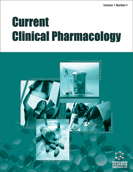Abstract
The enzyme poly(ADP)-ribose polymerase-1 (PARP-1) plays an important role in the repair of DNA damage via a mechanism called base excision repair (BER). Initially, inhibition of PARP-1 showed to be a promising anti-tumor strategy in preclinical models using BRCA1 and BRCA2 deficient tumor cell lines. More recently, several small molecules targeting PARP-1 entered the clinic and demonstrated compelling anti-tumor activity in patients with BRCA deficient breast and ovarian cancers, and in patients with triple-negative breast cancer. In this review we aim to summarize the most recent advances in the development of PARP inhibitors, with a focus on the clinical data.
Keywords: Synthetic lethality, repair mechanism, PARP, BRCA deficient, olaparib
Current Clinical Pharmacology
Title: Inducing Synthetic Lethality using PARP Inhibitors
Volume: 5 Issue: 3
Author(s): David S. Boss, Jos H. Beijnen and Jan H.M. Schellens
Affiliation:
Keywords: Synthetic lethality, repair mechanism, PARP, BRCA deficient, olaparib
Abstract: The enzyme poly(ADP)-ribose polymerase-1 (PARP-1) plays an important role in the repair of DNA damage via a mechanism called base excision repair (BER). Initially, inhibition of PARP-1 showed to be a promising anti-tumor strategy in preclinical models using BRCA1 and BRCA2 deficient tumor cell lines. More recently, several small molecules targeting PARP-1 entered the clinic and demonstrated compelling anti-tumor activity in patients with BRCA deficient breast and ovarian cancers, and in patients with triple-negative breast cancer. In this review we aim to summarize the most recent advances in the development of PARP inhibitors, with a focus on the clinical data.
Export Options
About this article
Cite this article as:
S. Boss David, H. Beijnen Jos and H.M. Schellens Jan, Inducing Synthetic Lethality using PARP Inhibitors, Current Clinical Pharmacology 2010; 5 (3) . https://dx.doi.org/10.2174/157488410791498798
| DOI https://dx.doi.org/10.2174/157488410791498798 |
Print ISSN 1574-8847 |
| Publisher Name Bentham Science Publisher |
Online ISSN 2212-3938 |
 16
16Related Articles
-
Muscarinic Acetylcholine Receptor-Interacting Proteins (mAChRIPs): Targeting the Receptorsome
Current Drug Targets Orphan Nuclear Receptors, Excellent Targets of Drug Discovery
Combinatorial Chemistry & High Throughput Screening Natural Sesquiterpenoids as Cytotoxic Anticancer Agents
Mini-Reviews in Medicinal Chemistry Design of Magnetic Nanoparticles-Assisted Drug Delivery System
Current Pharmaceutical Design Hsp90 Inhibitor Geldanamycin and Its Derivatives as Novel Cancer Chemotherapeutic Agents
Current Pharmaceutical Design The Current Role and Therapeutic Targets of Vitamin D in Gastrointestinal Inflammation and Cancer
Current Pharmaceutical Design Overcoming Drug Resistance by Enhancing Apoptosis of Tumor Cells
Current Cancer Drug Targets Blood-Brain Barrier and Breast Cancer Resistance Protein: A Limit to the Therapy of CNS Tumors and Neurodegenerative Diseases
Anti-Cancer Agents in Medicinal Chemistry Regulatory Approaches to Nonclinical Reproductive Toxicity Testing of Anti-Cancer Drugs
Anti-Cancer Agents in Medicinal Chemistry Comparison of Oxidative Stress and Inflammation Induced by Different Intravenous Iron Sucrose Similar Preparations in a Rat Model
Inflammation & Allergy - Drug Targets (Discontinued) Personalized Nanoparticles for Cancer Therapy: A Call for Greater Precision
Anti-Cancer Agents in Medicinal Chemistry Magnetic Resonance Spectroscopy Biomarkers in Term Perinatal Asphyxial Encephalopathy: From Neuropathological Correlates to Future Clinical Applications
Current Pediatric Reviews HER-2 Signaling and Inhibition in Breast Cancer
Current Cancer Drug Targets Class II Phosphoinositide 3-Kinases as Potential Novel Drug Targets
Current Signal Transduction Therapy Hypoglycemic Agents in the Management of Type 2 Diabetes Mellitus
Recent Patents on Endocrine, Metabolic & Immune Drug Discovery (Discontinued) A Hemagglutinin from Northeast Red Beans with Immunomodulatory Activity and Anti-proliferative and Apoptosis-inducing Activities Toward Tumor Cells
Protein & Peptide Letters Development of Arene Ruthenium Antitumor Complexes
Mini-Reviews in Medicinal Chemistry Thrombospondins as Anti-Angiogenic Therapeutic Agents
Current Pharmaceutical Design RNA Interference: New Therapeutics in Allergic Diseases
Current Gene Therapy Human Immunodeficiency Virus-Associated Malignancies: A Therapeutic Update
Current HIV Research






















